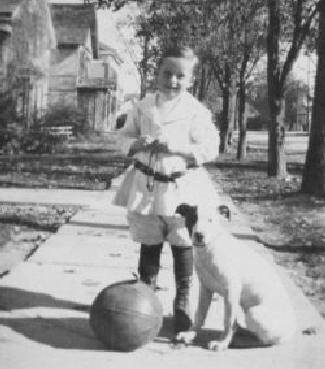Tunics were very popular for boys at the turn-of-the-century. We are not entirely sure when tunics became a major style. We do not see them very prominantly in the 1890s. But I don;t think they suddenly appeared in 1900. Thus we think they appeared in the late 90s. They seem to have been, however, prominant throughout the 1900s. We note them in advertising. A good example is Mellin's Food in 1903. Tunic suits were worn as both casual play outfits as well as for dressier occassions. The turn-of-the 20th century tunics were long, worn almost to the knees, longer than the mid- 19th century tunics which often looked more like shirts. There were many different styles. Sailor tunics were especially popular. A good example is the tunic suit worn by Ellis Gray Holden in 1908. There were different constructions. Some appear to have been pull-over garments. These tunics without noticeable buttons seem especially common in the 1900s. while others buttoned up the front or the side. They were usually worn with bloomer knickers. Sometimes you could barely see the bloomer knickers. Other tunics were made shorter so the bloomer knickers were quite prominent. There were both summer and winter tunics, the difference being the weight of the material. We note the Bingham boys wearing white summer tunics in 1908-09. A good example of a boy wearing a winter tunc is Harold Howes in 1905. An example of a boy wearing a summer tunic is Arthur Proulx in 1908. We also notice tunic suits made in the same muted plaids popular for kilt suits (figure 1). This is a convention we only notice in the 1900s.

Figure 2.--All we know about this snap shot is that the boy was American and photographed in 1911.
|
|
Tunics were very widely worn by American boys in both the 1900s and 1910s. Tunics continued to be a very popular garment for younger boys throughout the 1910s. We notice large numbers of offerings in the major catalogs during the 1910s. There are also many examples from the photographic record. As far as we can tell the tunic styles were very similar in both the 1900s and 1910s. We see tunics being done in different styles. Sailor tunics were especially popular, but there were other styles as well. Tunics suits were mostly worn with bloomer knickers. We also note a wide range of colors and detailing. The summer colors thst were most popular seem to have been white, blues and browns and to a lesser extent red. Detailing seems to have been somewhat less elaborate than in the 1900s. The heavier wunter tunics seem less common than in the 1900s. The tunics during the 1910s may have been cut somewhat shorter than during the 1900s. We have not been able to find enough dated photographs to be able to understand stylistic changes over time. We notice the Hubbard boys in 1917.
We still see tunics in the early 20s. We are not yet sure about catalog offerings. We note see photographs showing tunics in the early 20s. Again there do not seem to have been major stylistic changes, although we do noy yet have enough 1920s images to fully assess this. We think tunic styles may have persisted the longest. Tunics appear to have rapidly fallen out of style in the early 20s. Tunics were a relatively easy garment to sew at home so they may have persisted a few years after they disappeaed from the major catalogs. They seem to have persisted a little longer in rural than urban areas. We rarely see tunics by the mid-20s.
HBC

Navigate the Boys' Historical Clothing hair style pages:
[Return to the Main long hair page]
[Return to the Main curl hair page]
[Bangs]
[Ringlet curls]
[Hair bows]
[Caps]
[Collar bows]
Navigate the Boys' Historical Clothing Web Site:
[Return to the Main American tunic cronology page]
[Return to the Main American tunic page]
[Introduction]
[Activities]
[Biographies]
[Chronology]
[Clothing styles]
[Countries]
[Topics]
[Bibliographies]
[Contributions]
[FAQs]
[Glossaries]
[Images]
[Links]
[Registration]
[Tools]
[Boys' Clothing Home]
Created: 7:17 AM 9/23/2006
Last edited: 12:03 AM 8/19/2013



